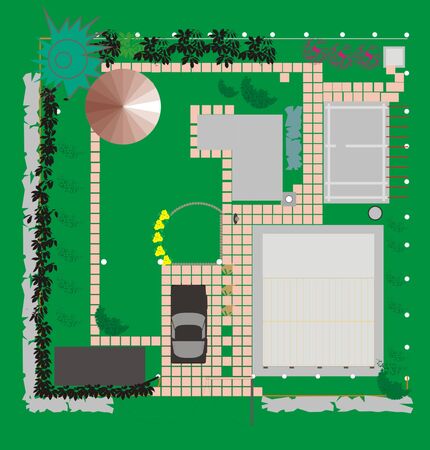Introduction to Xeriscaping in the American Landscape
Xeriscaping is a landscaping approach that emphasizes water efficiency, making it an ideal solution for homeowners and businesses across the United States who are looking to conserve resources and reduce utility costs. Rooted in the principles of thoughtful plant selection, soil improvement, efficient irrigation, mulching, and maintenance, xeriscaping is tailored to address the unique climate zones and water conservation challenges found throughout the country. From drought-prone regions in the Southwest to urban environments facing rising water rates and restrictions, Americans are increasingly turning to xeriscape methods not just for sustainability, but also for vibrant, low-maintenance outdoor spaces. Integrating rainwater harvesting and greywater systems into xeriscaping further elevates its impact, allowing property owners to capture and reuse water that would otherwise go to waste. This innovative combination supports local ecosystems, aligns with environmental regulations, and helps communities build resilience against future water shortages.
2. What is Rainwater Harvesting and Why It Matters
Rainwater harvesting is a sustainable landscaping practice that captures, stores, and reuses rainwater for irrigation and other non-potable uses. For American homeowners and property managers interested in xeriscaping—landscapes designed to minimize water use—rainwater harvesting is a smart way to reduce dependence on municipal water supplies. This approach not only lowers water bills but also helps conserve local water resources, especially important in regions facing drought or water restrictions. By implementing practical systems such as rain barrels, cisterns, or underground tanks, you can collect runoff from rooftops during storms and store it for dry spells. The table below highlights common methods of rainwater collection and their key benefits for residential landscapes.
| Method | Description | Benefits |
|---|---|---|
| Rain Barrels | Simple containers connected to downspouts to collect roof runoff | Easy installation; cost-effective; great for small gardens |
| Cisterns | Larger storage tanks above or below ground | High capacity; suitable for larger landscapes; integrated with irrigation systems |
| Permeable Paving | Paving surfaces that allow water infiltration and collection underneath | Reduces runoff; supports groundwater recharge; works well in urban settings |
For both single-family homes and multi-unit properties, adopting rainwater harvesting aligns perfectly with xeriscaping principles: using less potable water while supporting healthy, drought-resistant plantings. With these systems in place, you’ll not only make your landscape more resilient but also play a vital role in sustainable water management within your community.

3. Incorporating Greywater Systems in Home Gardens
Greywater systems are an innovative and sustainable way to enhance xeriscaping by recycling water from daily household activities. In the United States, using water efficiently is a growing priority, and greywater—water from sinks, showers, and washing machines—offers an eco-friendly solution for landscape irrigation. By diverting this gently used water, homeowners can reduce their potable water use while maintaining a healthy, vibrant garden.
How Greywater Can Be Used in Xeriscaping
Unlike blackwater (from toilets or kitchen sinks), greywater contains fewer contaminants and can be repurposed safely with minimal treatment. When integrated into xeriscape designs, greywater systems help irrigate drought-tolerant plants without putting extra strain on municipal supplies. For example, you can set up a simple laundry-to-landscape system that channels rinse water directly to your trees or shrubs. This supports plant growth in arid climates while keeping utility bills lower.
Safety Considerations and Best Practices
To ensure safety, always use biodegradable and low-sodium detergents if your greywater will reach your garden. Avoid using greywater on edible plant leaves but it’s safe for ornamentals and fruit trees when applied below the soil surface. Many U.S. states have specific guidelines for installing greywater systems; check local codes before making modifications. Filters and diverter valves can make switching between greywater and conventional systems easy, providing flexibility for seasonal changes or maintenance needs.
Benefits for American Homeowners
Incorporating greywater into your home garden not only conserves fresh water but also aligns with sustainable living trends popular across the U.S. It reduces wastewater going to treatment plants, lowers environmental impact, and helps create lush landscapes even during drought restrictions. By embracing greywater solutions within your xeriscape design, you’re investing in a resilient outdoor space that reflects American values of resourcefulness and environmental stewardship.
4. Design Strategies for Efficient Integration
Creating a successful xeriscape that incorporates both rainwater harvesting and greywater systems requires thoughtful design and planning. Here are some practical tips to ensure your landscape is not only water-efficient but also visually attractive and functional for daily living.
Tips for Seamless Integration
- Map Your Space: Start by analyzing your property’s layout, noting rooflines, natural slopes, and existing vegetation. Identify where water naturally flows and pools during rainfall—these are ideal spots for rain gardens or collection basins.
- Select Complementary Hardscape Materials: Use permeable pavers, gravel paths, and mulch to guide water to planted areas while adding texture and contrast to your xeriscape.
- Plan Planting Zones: Group plants with similar water needs together (hydrozoning). Place thirstier plants near greywater outlets or rainwater-fed swales, and drought-tolerant varieties farther away.
- Hide Infrastructure Creatively: Integrate cisterns, barrels, and greywater pipes behind screens, trellises, or shrubs. Decorative covers or custom-built enclosures can make these elements blend seamlessly into the design.
- Maximize Usability: Incorporate patios, seating areas, or pathways that allow easy access to all parts of the yard without disrupting water flow patterns.
Sample Layout: Rainwater & Greywater System Placement
| Element | Recommended Placement | Aesthetic Tip |
|---|---|---|
| Rain Barrels/Cisterns | Beneath downspouts; shaded side of the house | Add decorative paint or lattice screening |
| Greywater Outlets | Near flower beds or shrub borders | Hide with rocks or ornamental grasses |
| Bioswales/Rain Gardens | Low points in yard; along driveways/walkways | Plant with native wildflowers for color |
| Irrigation Lines | Subsurface within planting zones | Cover with mulch to keep invisible |
User-Friendly Design Considerations
- Keep Access in Mind: Ensure maintenance points like filter baskets or overflow valves are easy to reach but unobtrusive.
- Smooth Transitions: Use curved lines and organic shapes for beds and hardscapes to create a natural flow throughout the space.
- Lighting: Install low-voltage path lights or solar lanterns near key features to highlight your sustainable systems after dark.
Key Takeaway:
An integrated approach—combining smart layout, creative concealment, and thoughtful plant choices—will help you build a xeriscape that’s as beautiful as it is water-wise.
5. Regulations, Safety, and Maintenance in the U.S.
When integrating rainwater harvesting and greywater systems into xeriscaping, understanding and following U.S. regulations is essential. Water reuse laws can vary widely by state and even municipality. For example, states like Colorado have specific limits on rain barrel use, while others like California actively encourage both rainwater and greywater systems for landscape irrigation. Before starting your project, it’s crucial to check with local authorities about permits, approved system designs, and any restrictions related to water collection and reuse.
Navigating Local Laws
Many cities require permits for installing large-scale rainwater tanks or greywater systems. Some regions may restrict the types of plants irrigated with greywater or prohibit its use altogether in food gardens. Engaging with city planners or water departments early in the process helps ensure compliance and prevents costly mistakes down the road.
Health and Safety Guidelines
Rainwater and especially greywater can contain contaminants if not properly handled. The CDC and EPA provide guidelines for safe water reuse. For instance, greywater should only be used for subsurface irrigation to minimize contact with people and pets. Filtration, backflow prevention devices, and regular cleaning are recommended to prevent bacterial growth and cross-contamination with potable water supplies.
Maintenance Best Practices
Ongoing upkeep is key to long-term success. Routine inspection of tanks, filters, pumps, and irrigation lines ensures optimal system performance. Remove debris from rain barrels after storms and flush out lines periodically to prevent clogs. Greywater systems often need filter changes and pipe cleaning as well. Keeping a simple maintenance log can help you stay on track with required tasks, safeguarding both your xeriscape investment and your household’s health.
By proactively addressing regulations, safety protocols, and regular maintenance, homeowners can confidently use harvested rainwater and recycled greywater to support sustainable landscaping—and make the most of every drop in their eco-friendly outdoor spaces.
6. Success Stories: American Xeriscapes Making a Difference
Across the United States, homeowners and communities are embracing rainwater harvesting and greywater systems as part of their xeriscaping strategies, resulting in remarkable transformations and measurable water savings. These real-world success stories illustrate how innovative approaches can redefine both residential and public landscapes.
Case Study 1: Tucson’s Residential Revival
In Tucson, Arizona—a city that averages less than 12 inches of rain annually—residents like the Martinez family have revolutionized their yard by installing a rainwater catchment system and integrating greywater from laundry. By rerouting household greywater to irrigate native plants and using stored rainwater for trees, they’ve reduced potable water use for landscaping by more than 70%. Their desert garden now thrives year-round, blending beauty with sustainability.
Case Study 2: California Community Collaboration
In drought-prone Los Angeles, the Mar Vista Green Gardens project brought together neighbors to showcase water-smart landscaping. The community converted traditional lawns into xeriscapes featuring drip irrigation powered by rain barrels and subsurface greywater distribution. This collective effort not only cut outdoor water use by over half but also inspired local policy changes supporting sustainable landscaping incentives citywide.
Case Study 3: Colorado Schoolyard Transformation
At a Denver elementary school, faculty and students teamed up to replace turf grass with native wildflowers, shrubs, and mulch beds. The installation of a rooftop rainwater harvesting system allowed the garden to flourish even during dry spells. Additionally, bathroom sink greywater was channeled through biofiltration swales, supporting pollinator habitats while teaching kids about water conservation in action.
What We Can Learn
These examples prove that integrating rainwater harvesting and greywater reuse into xeriscaping isn’t just an environmental statement—it’s a practical solution delivering real benefits for households and communities alike. From reducing utility bills to building resilience against drought, American success stories show that every yard has the potential to make a difference when we rethink how we value and use water resources.


